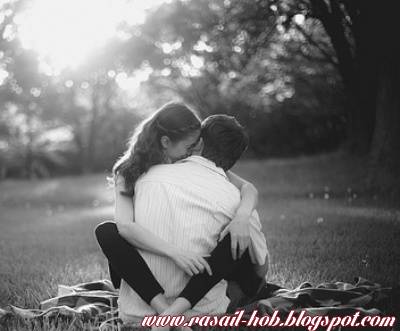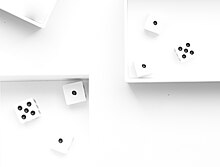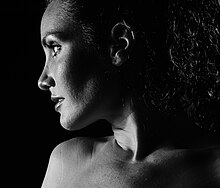![]()

Key light
Jump to navigation Jump to search
|
This article does not cite any sources. (March 2008) (Learn how and when to remove this template message)
|
The key light is the first and usually most important light that a photographer, cinematographer, lighting cameraman, or other scene composer will use in a lighting setup. The purpose of the key light is to highlight the form and dimension of the subject. The key light is not a rigid requirement; omitting the key light can result in a silhouette effect. Many key lights may be placed in a scene to illuminate a moving subject at opportune moments.
Position of camera
The key light can be “hard” (focused) or “soft” (diffused), and depending on the desired setup can be placed at different angles relative to the subject. When part of the most common setup—three-point lighting—the key light is placed at a 30–60° angle (with the camera marking 0 degrees). In addition to the horizontal angle, the key light can be placed high or low producing different effects. The most common vertical position for the key light is at a 30° angle (i.e. slightly above the eye line; the nose should not cast a shadow on the lips).
A key light positioned low appears to distort the actor’s features, since most natural or ambient light is normally overhead. A dramatic effect used in horror or comedy cinematography is a key light illuminating the face from below. A high key light will result in more prominent cheek bones and long nose shadows. Marlene Dietrich was famous for insisting that her key light be placed high.
Lighting a scene
Using just a key light results in a high-contrast scene, especially if the background is not illuminated. A fill light decreases contrast and adds more details to the dark areas of an image. An alternative to the fill light is to reflect existing light or to illuminate other objects in the scene, which in turn further illuminate the subject.
The key light does not have to directly illuminate the subject: it may pass through various filters, screens, or reflectors. Light passing through tree leaves, window panes, and other obstacles can make a scene more visually interesting, as well as cue the audience to the location of the subject. The key light also does not have to be white light—a colored key (especially when used with fill or back lighting of other colors) can add more emotional depth to a scene than full white alone. In mixed indoor/outdoor daytime scenes, sunlight may appear to be a warm white, and indoor lighting to be a neutral or artificially-toned white. By contrast, moonlight appears to be cooler than indoor lighting.
Lighting choices
In many cases, the key light is a stage light for indoor scenes, or sunlight for outdoors. A lighting instrument may also be used outdoors to supplement sunlight or as the primary light source with sunlight or skylight serving as fill lighting. Actual lamps, lighting fixtures, can serve as key lights, provided they are of sufficient brightness. They may also appear within the scene as props — in which case they are called “practicals.” Similarly, fire, candles and other natural sources of light can be used
ـــــــــــــــــــــــــــــــــــــــــــــــــــــــــــــــــــ

مفتاح الضوء
الضوء الرئيسي هو الضوء الأول والأهم عادة الذي سيستخدمه المصور الفوتوغرافي أو المصور السينمائي أو مصور الإضاءة أو مؤلف المشهد الآخر في إعداد الإضاءة. الغرض من الضوء الرئيسي هو تسليط الضوء على شكل وأبعاد الموضوع. الضوء الرئيسي ليس متطلبًا جامدًا ؛ يمكن أن يؤدي حذف الضوء الرئيسي إلى تأثير صورة ظلية . يمكن وضع العديد من الأضواء الرئيسية في مشهد لإضاءة هدف متحرك في اللحظات المناسبة.
محتويات
الكاميرا
يمكن أن يكون الضوء الرئيسي “صعبًا” (مركّزًا) أو “ناعمًا” (منتشرًا) ، ويمكن اعتمادًا على الإعداد المطلوب في زوايا مختلفة بالنسبة إلى الهدف. عندما يكون جزءًا من الإعداد الأكثر شيوعًا – إضاءة من ثلاث نقاط – يتم وضع ضوء المفتاح بزاوية 30-60 درجة (مع وضع علامة على الكاميرا 0 درجة). بالإضافة إلى الزاوية الأفقية ، يمكن وضع المصباح الرئيسي عاليًا أو منخفضًا مما ينتج عنه تأثيرات مختلفة. الوضع الرأسي الأكثر شيوعًا للضوء الرئيسي هو بزاوية 30 درجة (أي أعلى قليلاً من خط العين ؛ يجب ألا يلقي الأنف ظلًا على الشفاه).
يبدو أن الضوء الرئيسي الموجود في موضع منخفض يشوه ميزات الممثل ، حيث أن معظم الضوء الطبيعي أو المحيط عادة ما يكون فوق الرأس. التأثير الدرامي المستخدم في التصوير السينمائي الرعب أو الكوميدي هو ضوء رئيسي يضيء الوجه من الأسفل. سينتج عن الضوء الرئيسي المرتفع عظام خد بارزة وظلال أنف طويلة. اشتهرت مارلين ديتريش بإصرارها على وضع ضوءها الرئيسي عالياً.
إضاءة مشهد
يؤدي استخدام ضوء رئيسي فقط إلى مشهد عالي التباين ، خاصة إذا لم تكن الخلفية مضاءة. يقلل ضوء التعبئة من التباين ويضيف المزيد من التفاصيل إلى المناطق المظلمة من الصورة. بديل لضوء التعبئة هو عكس الضوء الموجود أو إضاءة أشياء أخرى في المشهد ، والتي بدورها تضيء الهدف بشكل أكبر.
لا يلزم أن يضيء المصباح الرئيسي الهدف مباشرة: فقد يمر عبر مرشحات أو شاشات أو عاكسات مختلفة. يمكن أن يؤدي الضوء الذي يمر عبر أوراق الشجر وأجزاء النوافذ والعقبات الأخرى إلى جعل المشهد أكثر إثارة للاهتمام ، بالإضافة إلى توجيه الجمهور إلى موقع الموضوع. لا يجب أن يكون الضوء الرئيسي أيضًا ضوءًا أبيض – يمكن أن يضيف المفتاح الملون (خاصة عند استخدامه مع إضاءة التعبئة أو الألوان الخلفية الأخرى) عمقًا عاطفيًا للمشهد أكثر من الأبيض الكامل وحده. في المشاهد النهارية الداخلية / الخارجية المختلطة ، قد يبدو ضوء الشمس بلون أبيض دافئ ، وإضاءة داخلية لتكون بيضاء محايدة أو ذات لون مصطنع. على النقيض من ذلك ، يبدو ضوء القمر أكثر برودة من الإضاءة الداخلية.
خيارات الإضاءة
في كثير من الحالات ، يكون الضوء الرئيسي هو ضوء المرحلة للمشاهد الداخلية ، أو ضوء الشمس في الهواء الطلق. يمكن أيضًا استخدام أداة الإضاءة في الهواء الطلق لتكملة ضوء الشمس أو كمصدر للضوء الأساسي مع ضوء الشمس أو منور يعمل بمثابة إضاءة تعبئة. المصابيح الفعلية ، تركيبات الإضاءة ، يمكن أن تعمل كمصابيح رئيسية ، شريطة أن تكون ذات سطوع كافٍ. قد تظهر أيضًا في المشهد كدعائم – وفي هذه الحالة يطلق عليهم “العمليون”. وبالمثل ، يمكن استخدام النار والشموع ومصادر الضوء الطبيعية الأخرى
High-key lighting
Jump to navigation Jump to search
|
This article needs additional citations for verification. (February 2013) (Learn how and when to remove this template message)
|
High-key lighting is a style of lighting for film, television, or photography that aims to reduce the lighting ratio present in the scene. This was originally done partly for technological reasons, since early film and television did not deal well with high contrast ratios, but now is used to suggest an upbeat mood. It is often used in sitcoms and comedies. High-key lighting is usually quite homogeneous and free from dark shadows. The terminology comes from the higher balance in the ratio between the key light and the fill light in a traditional three point lighting setup.[1]
In the 1950s and 1960s, high-key lighting was achieved through multiple light sources lighting a scene—usually using three fixtures per person (left, right, and central) —which resulted in a uniform lighting pattern with very little modeling. Nowadays, multiple hot light sources are replaced with much more efficient fluorescent soft lights which provide a similar effect.
The advantage to high-key lighting is that it doesn’t require adjustment for each scene which allows the production to complete the shooting in hours instead of days. The primary drawback is that high-key lighting fails to add meaning or drama by lighting certain parts more prominently than others.
Shows with bigger budgets have moved away from high-key lighting by using lighting set-ups different from the standard three-point lighting. Part of the reason for this is the advent of new lighting fixtures which are easier to use and quicker to set up. Another reason is the growing sophistication of the audience for TV programs and the need to differentiate.
Movies
High-key lighting found its use in classical Hollywood cinema because it was well suited for three-point lighting and other filmmaking traditions. It is an overall lighting design which uses the fill light and backlight to create low contrast between brighter and darker areas. It can be used for both daylight and night scenes.[2]
ــــــــــــــــــــــــــــــــــــــــــــــــ

Low-key lighting
Low-key lighting is a style of lighting for photography, film or television. It is a necessary element in creating a chiaroscuro effect.[1] Traditional photographic lighting, three-point lighting uses a key light, a fill light and a back light for illumination. Low-key lighting often uses only a key light, optionally controlled with a fill light or a simple reflector.
Low key light accentuates the contours of the subject by throwing areas into shade while a fill light or reflector may illuminate the shadow areas to control contrast.[2][1] The relative strength of key-to-fill, known as the lighting ratio, can be measured using a light meter. Low key lighting has a higher lighting ratio, e.g., 8:1, than high-key lighting, which can approach 1:1.
The term “low key” is also used in cinematography and photography to refer to any scene with a high lighting ratio, especially if there is a predominance of shadowy areas. It tends to heighten the sense of alienation felt by the viewer, hence is commonly used in film noir and horror genres.[1] It is typically used in dark dramas/ thrillers. Low-key lighting is also associated with German Expressionism and later film noir.






